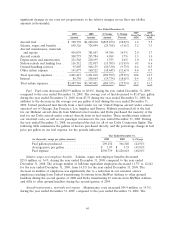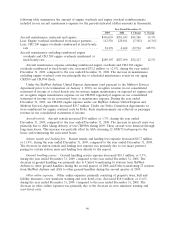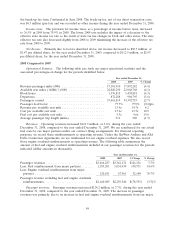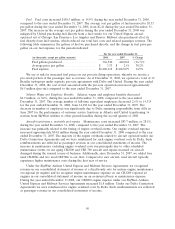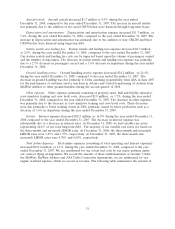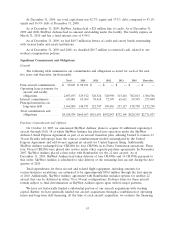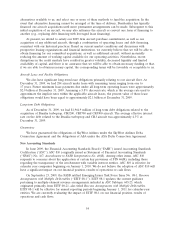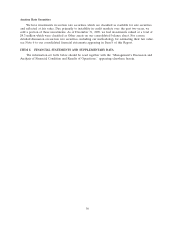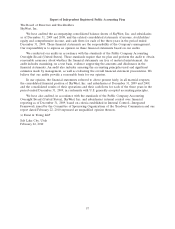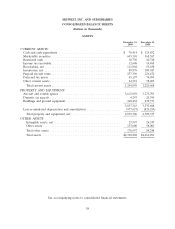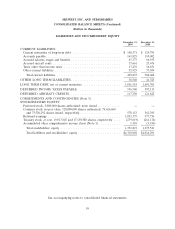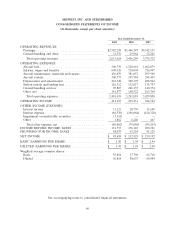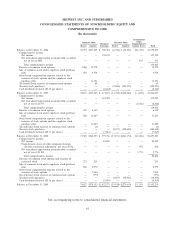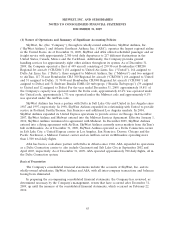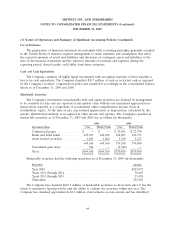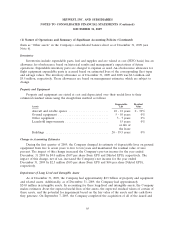SkyWest Airlines 2009 Annual Report Download - page 59
Download and view the complete annual report
Please find page 59 of the 2009 SkyWest Airlines annual report below. You can navigate through the pages in the report by either clicking on the pages listed below, or by using the keyword search tool below to find specific information within the annual report.ITEM 7A. QUANTITATIVE AND QUALITATIVE DISCLOSURES ABOUT MARKET RISK
Aircraft Fuel
In the past, we have not experienced difficulties with fuel availability and we currently expect to be
able to obtain fuel at prevailing prices in quantities sufficient to meet our future needs. Pursuant to our
contract flying arrangements, United has agreed to bear the economic risk of fuel price fluctuations on
our contracted United Express flights. On our Delta Connection regional jet flights, Delta has agreed
to bear the economic risk of fuel price fluctuations. We bear the economic risk of fuel price
fluctuations on our pro-rate operations. For the year ended December 31, 2009, essentially all of our
Brasilia turboprops flown for Delta were flown under pro-rate arrangements while, approximately 47%
of our Brasilia turboprops flown in the United system were flown under pro-rate arrangements and
approximately 4% of our CRJ200s flown in the United system were flown under pro-rate arrangements.
As of December 31, 2009, we operated 14 CRJ 200s under a pro-rate agreement with United and two
CRJ200s with AirTran. The average price per gallon of aircraft fuel decreased 43.8% to $1.87 for the
year ended December 31, 2009, from $3.33 for the year ended December 31, 2008. For illustrative
purposes only, we have estimated the impact of the market risk of fuel on our pro-rate operations
using a hypothetical increase of 25% in the price per gallon we purchase. Based on this hypothetical
assumption, we would have incurred an additional $7.5 million in fuel expense for the year ended
December 31, 2009.
Interest Rates
Our earnings are affected by changes in interest rates due to the amounts of variable rate
long-term debt and the amount of cash and securities held. The interest rates applicable to variable
rate notes may rise and increase the amount of interest expense. We would also receive higher amounts
of interest income on cash and securities held at the time; however, the market value of our
available-for-sale securities would likely decline. At December 31, 2009, we had variable rate notes
representing 38.6% of our total long-term debt compared to 46.6% of our long-term debt at
December 31, 2008. For illustrative purposes only, we have estimated the impact of market risk using a
hypothetical increase in interest rates of one percentage point for both variable rate long-term debt and
cash and securities. Based on this hypothetical assumption, we would have incurred an additional
$8.0 million in interest expense and received $7.4 million in additional interest income for the year
ended December 31, 2009 and we would have incurred an additional $8.8 million in interest expense
and received $6.7 million in additional interest income for the year ended December 31, 2008.
However, under our contractual arrangement with our major partners, the majority of the increase in
interest expense would be passed through and recorded as passenger revenue in our consolidated
statements of income. Also for illustrative purposes only, we have likewise estimated the impact of a
hypothetical decrease in interest rates of one percentage point for both variable rate long-term debt
and cash and securities. Based upon this hypothetical example, we would have recognized $8.0 million
less in interest expense and received $7.4 less in interest income for the year ended December 31, 2009,
and we would have recognized $8.8 million less in interest expense and received $6.7 less in interest
income for the year ended December 31, 2008. If interest rates were to decline, our major partners
would receive the principal benefit of the decline, since interest expense is generally passed through to
our major partners, resulting in a reduction to passenger revenue in our consolidated statement of
income.
We currently intend to finance the acquisition of aircraft through manufacturer financing, third-
party leases or long-term borrowings. Changes in interest rates may impact our actual costs of acquiring
these aircraft.
55


